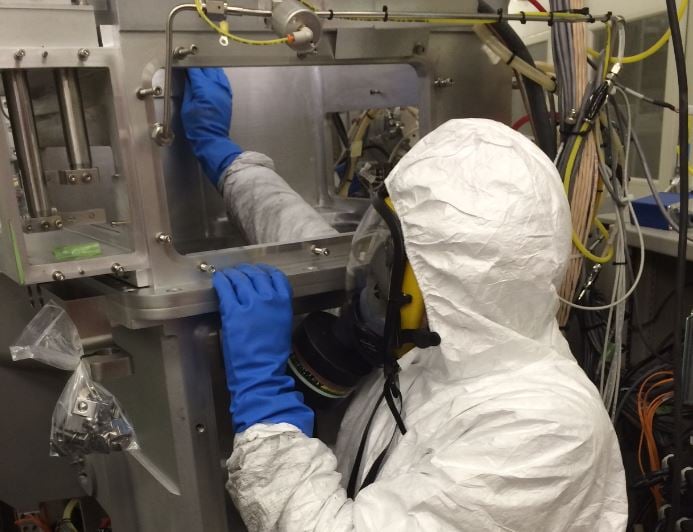Factory de-installations are never simple. But they’re a lot easier when you do them right.
![]()
Nobody knows this better than IES senior engineer, Brian Fletcher.
Brian has an impressive 50+ years of experience as a specialist installation engineer, vast knowledge of more than 300 different tools, and his claim to fame here at IES is that he completed our first-ever equipment installation.
As someone who’s spent over half a century accumulating all sorts of knowledge on factory relocations, handling different types of complex equipment and dealing with unexpected challenges, we sat down with Brian to hear his thoughts on how to get the de-installation process right and to capture some of his expert insights.
Know What You’re Working With
De-installing and reinstalling an entire factory is no mean feat.
In a manufacturing facility making silicon chips, for example, there’ll often be around 450 different tools—all ranging in complexity, purpose and size.
For Brian, the number one priority at the start of each de-installation is to gain a thorough understanding of what he’s working with before starting the process.
"You have to be able to understand those tools before you power them down and before you start to disconnect them," he says. "Because you've probably got to then put them back somewhere else."
The best way to do this is by creating a "fingerprint" of each piece of equipment that establishes its characteristics, the quality of its vacuum, the accuracy of the temperatures in its heater and other qualities. This will help your team to replicate the same fingerprint after you’ve re-installed the equipment.
If the tool is powered down before you’ve had a chance to inspect it or create that fingerprint, this can throw a major spanner in the works…
“I’ve had many cases where I’ve gone to a tool to deinstall it and the power has already been removed,” Brian adds. “When it’s come to the reinstallation, I’ve then discovered that it was broken before it was de-installed, so we’ve had to fix it before we can actually get it operational.”
That’s why it’s so important to fully inspect your equipment before you start to de-install it.
Be Wary of Misinformation
Brian recalls a job that IES took on in France: “The tool had all been powered down, and the client certified that it was clean. It wasn’t clean at all—it was still full of acid.”
This misinformation meant that IES had to simply walk away from the job. “You can’t do anything about it,” Brian says, “it’s a completely different beast. The presence of acid means that a hazmat suit, full breathing apparatus and the right cleaning materials are needed.”
In the end, Brian and a colleague went back to fully decontaminate the tool several months later, which he describes as “a nightmare of a job.”
The tool itself had been decommissioned several years previously, but parts had been removed to repair sister tools on the same site. And to decontaminate and deinstall a piece of equipment, it has to be functioning as it should.
Fully Decontaminate Equipment
One of the major misconceptions of de-installing contaminated equipment, according to Brian, is the belief that a gentle clean will suffice.

But neglecting to fully decontaminate equipment can cause not only significant damage to the equipment itself but also pose a major health risk to all employees involved.
Hydrochloric acid, for example, can corrode your equipment if it’s not properly removed before de-installation.
“Hydrochloric acid reacts with moisture. So if you get some moisture with it, it corrodes everything—stainless steel, everything. So you have to make sure you clean every tiny part off before you can move on,” Brian explains.
“I’ve seen equipment that I’ve been told has been cleaned but I look inside and it’s reasonably clean but it’s not fully decontaminated. It’ll then sit in a warehouse for a year before someone reinstalls it, and by that time it’s rusted away—and it’s a piece of junk”.
The same goes for semiconductor equipment that uses either phosphorous or arsenic—two incredibly hazardous materials that are poisonous for humans (arsenic lethally so). Additionally, if a pyrophoric gas like phosphorus isn’t removed prior to air freighting, it could ignite during the flight.
Yet, “Often you’ll find that clients have only done a partial clean rather than a full decontamination,” Brian says.
“The only way you get equipment clean after you’ve used those materials is elbow grease. Basically, you scrub them with Scotch-Brite for hours and hours, while wearing full face masks.”
Size Matters
A manufacturing facility will often change and evolve over the years. A single building may end up with extra space tacked on to accommodate the business’s growth.
And that’s all well and good—until the time comes to relocate.
“Sometimes you’ll look at equipment and think, ‘Alright, how are we going to get this out of the building?’” Brian says. “It may be that the door where it originally came in is now a new building.”
What seemed like a simple process at first becomes far more difficult when a tool is too large to get through the doors.
“I’ve been to a few jobs where we’ve had to crane it through the roof”, adds Brian. “There have also been times when we’ve had to decommission a piece of equipment into a smaller state than intended—breaking it down into much smaller bits, which really adds to the complication.”
Removing parts from equipment that weren’t designed to be removed, purely to fit it through a doorway or out of a facility, is not ideal.
At IES, we’ve experienced a fair few jobs like this over the years. These really highlight the importance of accurate and thorough planning. Which brings us on to our next point…
Site Surveys Are Essential
Full, comprehensive site surveys are vital for any project you undertake.
They help you understand the layout of both the old and new sites, equipment specifications and any factors (like slopes or narrow doorways) that will impact the job.
"Sometimes," Brian says, "you have to rely on what the customer has told you. If it's a factory 1,000 miles away, that cost can't be taken up by the contract. So, you rely on the client to give you the weights, sizes and measurements.”
While these measurements should never be wrong, Brian understands how mistakes at the client's end can happen.
"Sometimes you'll look at the specification of the tool and it gives a certain measurement, but in reality, it's been modified so it's bigger than the spec says. It doesn't happen very often, but it does happen."
The Equipment’s Age Can Cause Problems
“When equipment is bought new, it includes a caging kit,” Brian says. “A series of brackets and bolts to secure the robot or any moving parts.”
But those parts can easily be lost over time. Especially if the equipment is decades old.
“You can have a working robot, but if you don’t secure it, it’s junk by the time it gets to the other end,” Brian says. “So you have to fabricate bespoke packaging to secure various parts.”
You should also factor in equipment age when dealing with cabling. “Every cable has a label on it when it’s new,” Brian says. “It has a designated position, it has a designated number, you can easily find where that cable came from.”
But 20-year-old cables? The labels will likely have worn off or will be unreadable.
“In this situation,” says Brian, “if you start disconnecting cables willy-nilly it’s a nightmare to try and put it back together. So here, you’d label every single cable”.
He highlights one job in France where the de-installation included removing the best part of 500 electrical cables - with each cable 100 metres long. And every cable had to be labelled so they could put it back together correctly on the other end.
De-install Complex Equipment with Total Confidence
Equipment de-installation is a mammoth task - one whose size and complexity are all-too-easy to overlook.
We’ve been de-installing, relocating and installing complex, business-critical equipment since 1991, working with some of the top semiconductor and pharmaceutical companies.
Learn more about our equipment de-installations and installations service here.




